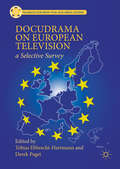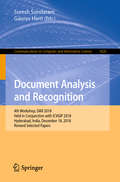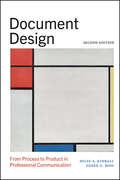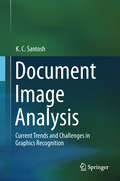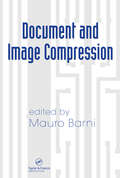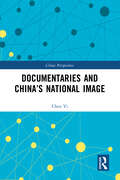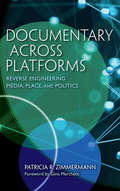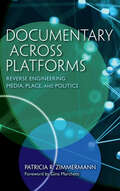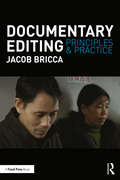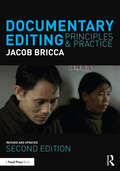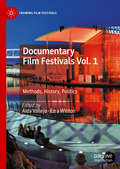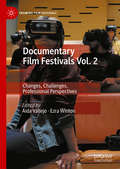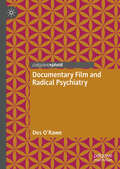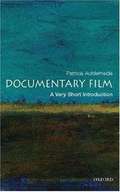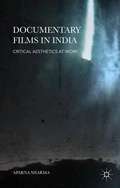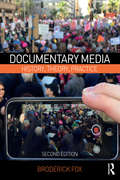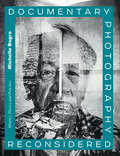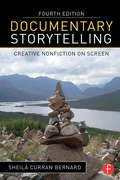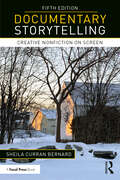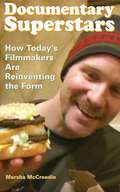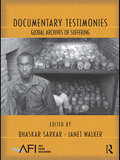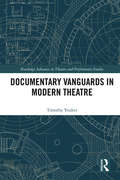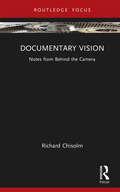- Table View
- List View
Doctoral Symposium on Information and Communication Technologies: Second Doctoral Symposium, DSICT 2022, Manta, Ecuador, October 12–14, 2022, Proceedings (Communications in Computer and Information Science #1647)
by Santiago Berrezueta Karina AbadThis book constitutes the refereed proceedings of the Second Doctoral Symposium on Information and Communication Technologies, DSICT 2022, held in Manta, Ecuador, in October 2022. The 15 full papers were thoroughly reviewed and selected from the 72 submissions. The papers present research in areas of intelligent systems, artificial intelligence, ICTs and their applications to the real world.
Docudrama on European Television
by Tobias Ebbrecht-Hartmann Derek PagetThis book explores docudrama as a creative response to troubled times. With generic characteristics formed via traditions in theatre as well as film, and with claims to fact underscored by investigative journalism, television docudrama examines key events and personalities in unfolding national histories. Post-Fall of the Berlin Wall, docudrama has become a means for nations to work through traumatic experiences both within national borders and Europe-wide. In this regard, it is an important genre for television networks as they attempt to make sense of complex current events. These authors offer a template for further study and point towards ways in which European television cultures, beyond those discussed here, might be considered in the future.
Document Analysis and Recognition: 4th Workshop, DAR 2018, Held in Conjunction with ICVGIP 2018, Hyderabad, India, December 18, 2018, Revised Selected Papers (Communications in Computer and Information Science #1020)
by Suresh Sundaram Gaurav Harit1. This book constitutes the refereed proceedings of the 4th Workshop on Document Analysis and Recognition, DAR 2018, held in Conjunction with ICVGIP 2018, in Hyderabad, India, in December 2018. The 12 revised full papers and 2 short papers presented were carefully reviewed and selected from 22 submissions. The papers are organized in topical sections: document layout analysis and understanding; handwriting recognition and symbol spotting; character and word segmentation; handwriting analysis; datasets and performance evaluation.
Document Design: From Process to Product in Professional Communication (SUNY series, Studies in Technical Communication)
by Miles A. Kimball Derek G. RossIntroduces students to the basic principles and theories of design, combining practical advice about the design process with a foundation in visual rhetoric and usability.Document Design introduces students to the basic principles and theories of design, combining practical advice about the design process with a foundation in visual rhetoric and usability. Most books on document design lean toward either theory or practice. This book offers a balanced approach-theoretically informed practice-that introduces a working vocabulary to help students become reflective practitioners, able not only to create effective designs but also to explain why and how they made their design choices. Derek G. Ross and Miles A. Kimball hope to give students the foundation they need to make design decisions in any rhetorical situation. Students will learn to negotiate between the needs of both users and clients to consider the nuances of audience, purpose, and context.
Document Image Analysis: Current Trends And Challenges In Graphics Recognition
by K. C. SantoshThe book focuses on one of the key issues in document image processing – graphical symbol recognition, which is a sub-field of the larger research domain of pattern recognition. It covers several approaches: statistical, structural and syntactic, and discusses their merits and demerits considering the context. Through comprehensive experiments, it also explores whether these approaches can be combined. The book presents research problems, state-of-the-art methods that convey basic steps as well as prominent techniques, evaluation metrics and protocols, and research standpoints/directions that are associated with it. However, it is not limited to straightforward isolated graphics (visual patterns) recognition; it also addresses complex and composite graphical symbols recognition, which is motivated by real-world industrial problems.
Document and Image Compression (Signal Processing and Communications)
by Mauro BarniAlthough it's true that image compression research is a mature field, continued improvements in computing power and image representation tools keep the field spry. Faster processors enable previously intractable compression algorithms and schemes, and certainly the demand for highly portable high-quality images will not abate. Document and Image Compression highlights the current state of the field along with the most probable and promising future research directions for image coding.Organized into three broad sections, the book examines the currently available techniques, future directions, and techniques for specific classes of images. It begins with an introduction to multiresolution image representation, advanced coding and modeling techniques, and the basics of perceptual image coding. This leads to discussions of the JPEG 2000 and JPEG-LS standards, lossless coding, and fractal image compression. New directions are highlighted that involve image coding and representation paradigms beyond the wavelet-based framework, the use of redundant dictionaries, the distributed source coding paradigm, and novel data-hiding techniques. The book concludes with techniques developed for classes of images where the general-purpose algorithms fail, such as for binary images and shapes, compound documents, remote sensing images, medical images, and VLSI layout image data. Contributed by international experts, Document and Image Compression gathers the latest and most important developments in image coding into a single, convenient, and authoritative source.
Documentaries and China’s National Image (China Perspectives)
by Chen YiEmphasizing the role of documentary in shaping a nation-state’s image, demonstrating social development and promoting cultural exchanges, this book examines the changes in China’s national image in documentaries at home and abroad since 1949. Based on theoretical frameworks of media sociology, political economy of communication and cultural studies, the book traces the development of Chinese documentary and discusses social transformation and cultural representation embodied in documentaries related to China. It is revealed how these works witness, reflect and interact with social transitions in all aspects of a modernizing China, as well as how documentary production struggles among and mediates between technology, market, ideology, social forces and professionalism. In terms of future prospects of documentary in an era when media convergence is burgeoning, the author explores feasible paths to further promotion of cross-cultural communication and China’s national image, by analyzing documentary aesthetics and representative cases of documentary practice. The title will appeal to scholars and students interested in culture and communication, documentary, film, media and Chinese society.
Documentary Across Platforms: Reverse Engineering Media, Place, and Politics
by Patricia R. ZimmermannIn Documentary Across Platforms, noted scholar of film and experimental media Patricia R. Zimmermann offers a glimpse into the ever-evolving constellation of practices known as "documentary" and the way in which they investigate, engage with, and interrogate the world. Collected here for the first time are her celebrated essays and speculations about documentary, experimental, and new media published outside of traditional scholarly venues. These essays envision documentary as a complex ecology composed of different technologies, sets of practices, and specific relationships to communities, engagement, politics, and social struggles. Through the lens of reverse engineering—the concept that ideas just like objects can be disassembled to learn how they work and then rebuilt into something new and better—Zimmermann explores how numerous small-scale documentary works present strategies of intervention into existing power structures. Adaptive to their context, modular, and unfixed, the documentary practices she explores exploit both sophisticated high-end professional and consumer-grade amateur technologies, moving through different political terrains, different platforms, and different exhibition contexts. Together these essays demonstrate documentary’s role as a conceptual practice to think through how the world is organized and to imagine ways that it might be reorganized with actions, communities, and ideas.
Documentary Across Platforms: Reverse Engineering Media, Place, and Politics
by Patricia R. ZimmermannEssays “capturing media ecologies as varied as museum installations, film festival showings, photography, and multiple varieties of internet sharing.” —Jump CutIn Documentary Across Platforms, noted scholar of film and experimental media Patricia R. Zimmermann offers a glimpse into the ever-evolving constellation of practices known as “documentary” and the way in which they investigate, engage with, and interrogate the world.Collected here for the first time are her celebrated essays and speculations about documentary, experimental, and new media published outside of traditional scholarly venues. These essays envision documentary as a complex ecology composed of different technologies, sets of practices, and specific relationships to communities, engagement, politics, and social struggles. Through the lens of reverse engineering—the concept that ideas, just like objects, can be disassembled to learn how they work and then rebuilt into something new and better—Zimmermann explores how numerous small-scale documentary works present strategies of intervention into existing power structures. Adaptive to their context, modular, and unfixed, the documentary practices she explores exploit both sophisticated high-end professional and consumer-grade amateur technologies, moving through different political terrains, different platforms, and different exhibition contexts.Together these essays demonstrate documentary’s role as a conceptual practice to think through how the world is organized and to imagine ways that it might be reorganized with actions, communities, and ideas.
Documentary Editing: Principles & Practice
by Jacob BriccaDocumentary Editing offers clear and detailed strategies for tackling every stage of the documentary editing process, from organizing raw footage and building select reels to fine cutting and final export. Written by a Sundance award- winning documentary editor with a dozen features to his credit and containing examples from over 100 films, this book presents a step-by-step guide for how to turn seemingly shapeless footage into focused scenes, and how to craft a structure for a documentary of any length. The book contains insights and examples from seven of America’s top documentary editors, including Geoffrey Richman (The Cove, Sicko), Kate Amend (The Keepers, Into the Arms of Strangers), and Mary Lampson (Harlan County U.S.A.), and a companion website contains easy-to-follow video tutorials. Written for both practitioners and enthusiasts, Documentary Editing offers unique and invaluable insights into the documentary editing process. The companion website is still in production. In the meantime, you can access Jacob's video tutorials on his YouTube Channel at the following URL: https://www.youtube.com/channel/UCKW7MVayB_-Cs4cCM47jdKQ?disable_polymer=true
Documentary Editing: Principles & Practice
by Jacob Bricca, ACEThis book offers clear and detailed strategies for tackling every stage of the documentary editing process, from organizing raw footage and building select reels to fine cutting and final export. Written by a Sundance award-winning documentary editor with a dozen features to his credit and containing examples from over 100 films, this book presents a step-by-step guide for how to turn seemingly shapeless footage into focused scenes, and how to craft a structure for a documentary of any length. The book contains insights and examples from seven of America’s top documentary editors, including Geoffrey Richman, ACE (The Cove, Tiger King), Kate Amend, ACE (¡Viva Maestro!, The Keepers), and Mary Lampson (Harlan County U.S.A.). Written for both practitioners and enthusiasts, this book offers unique and invaluable insights into the documentary editing process. The second edition is completely revised and updated with contemporary examples and contains a new chapter titled, "Editing the Short Documentary."
Documentary Film Festivals Vol. 1: Methods, History, Politics (Framing Film Festivals)
by Ezra Winton Aida VallejoThis book provides the first comprehensive overview of the global landscape of documentary film festivals. Contributors from across the globe offer in-depth analysis of both internationally renowned and more alternative festivals, including Hot Docs (Canada), Nyon (Switcherland), Yamagata (Japan), DocChina, Full Frame (US), Belgrade (former Yugoslavia), Vikalp (India), and DocsBarcelona (Catalonia, Spain), among others. With a special focus on historical and political developments, this first volume draws a map of documentary festivals operating today, and then looks at their origins and evolution. This volume is organized in three sections: the first addresses methodological problems film historians and social scientists face when researching documentary film festivals, the second looks at the historical development of this circuit within the wider frame of history of world and national cinemas, and the third reflects on how politics find their way through festival programs and actions. Curatorial, organizational, industrial and political changes occurred in the festival realm addressed in this book help better understand how these affected documentary production, distribution, curation, exhibition and reception up to this day.
Documentary Film Festivals Vol. 2: Changes, Challenges, Professional Perspectives (Framing Film Festivals)
by Ezra Winton Aida VallejoThis book provides the first comprehensive overview of the global landscape of documentary film festivals, looking at its contemporary and future challenges. Contributors from across the globe reflect on how documentary has positioned itself within both internationally renowned and more alternative festivals, including IDFA (Netherlands), Cannes IFF (France), Sheffield Doc/Fest (UK), Dockanema (Mozambique), Ismailia (Egypt) and Zinebi (Basque Country, Spain), among others. With a special focus on industrial and curatorial developments, this second in a two-volume set looks at recent changes occurred in the festival circuit, such as the proliferation of markets and co-production forums, the inclusion of interactive and VR forms within their programs and the irruption of VOD platforms, and analyse how these affect the future of documentary aesthetics and its production/distribution contexts.This volume is organized in two sections: the first reflects on how the documentary festival circuit has become a key industry node for contemporary documentary and identifies new curatorial trends at documentary and major film festivals. The second gives voice to professionals working for festivals and institutions who collaborate with them, who share inside knowledge and concerns, regarding the future challenges to be faced by documentary in the near future.
Documentary Film and Radical Psychiatry
by Des O'RaweThis book examines how documentary film responded to the methods and controversies associated with radical psychiatry, especially during the long 1960s. Broad in scope and comparative in approach, it discusses a range of films in terms of how their production histories and visual styles were influenced by wider cultural, technological, and autobiographical factors. The book argues that documentary filmmaking offers both an important critical perspective on psychiatric treatments, institutions, and attitudes, as well as contributing to a critique of how normative modes of being are constructed across mainstream media and popular culture. In their negotiations with the politics of psychiatry, such films will often question the ethnographic and observational integrity of the documentary or “non-fiction” form itself, especially when it adopts diaristic, interactive, socially engaged and advocatory strategies to represent mental illness and healthcare provision. The relationship between documentary film and the constellation of insights, arguments, communities, and individuals associated with the moment of radical psychiatry remains a complex but indispensable legacy of the post-war era.
Documentary Film: A Very Short Introduction
by Patricia AufderheideDocumentary film can encompass anything from Robert Flaherty's pioneering ethnography Nanook of the North to Michael Moore's anti-Iraq War polemic Fahrenheit 9/11, from Dziga Vertov's artful Soviet propaganda piece Man with a Movie Camera to Luc Jacquet's heart-tugging wildlife epic March of the Penguins. In this concise, crisply written guide, Patricia Aufderheide takes readers along the diverse paths of documentary history and charts the lively, often fierce debates among filmmakers and scholars about the best ways to represent reality and to tell the truths worth telling. Beginning with an overview of the central issues of documentary filmmaking--its definitions and purposes, its forms and founders--Aufderheide focuses on several of its key subgenres, including public affairs films, government propaganda (particularly the works produced during World War II), historical documentaries, and nature films. Her thematic approach allows readers to enter the subject matter through the kinds of films that first attracted them to documentaries, and it permits her to make connections between eras, as well as revealing the ongoing nature of documentary's core controversies involving objectivity, advocacy, and bias. Interwoven throughout are discussions of the ethical and practical considerations that arise with every aspect of documentary production. A particularly useful feature of the book is an appended list of "100 great documentaries" that anyone with a serious interest in the genre should see. Drawing on the author's four decades of experience as a film scholar and critic, this book is the perfect introduction not just for teachers and students but also for all thoughtful filmgoers and for those who aspire to make documentaries themselves.
Documentary Films in India
by Aparna SharmaThis book introduces the diverse practices of documentary films in India. It examines the oeuvres of three non-canonical practitioners: ethnographic filmmaker, David MacDougall; northeast India-based moving-image artists group, Desire Machine Collective; and avant-garde filmmaker and cinema philosopher, Kumar Shahani. Sharma offers in-depth analysis of these practitioners' distinct documentary methods and aesthetics, exploring how their oeuvres constitute a critical and self-reflexive approach to documentary-making in India.
Documentary Media: History, Theory, Practice
by Broderick FoxIn a digital moment where both the democratizing and totalitarian possibilities of media are unprecedented, the need for complex, ethical, and imaginative documentary media—for you, the reader of this book to think, question, and create—is vital. Whether you are an aspiring or seasoned practitioner, an activist or community leader, a student or scholar, or simply a curious audience member, author Broderick Fox opens up documentary media, its changing forms, and diversifying social functions to readers in a manner that is at once rigorous, absorbing, and practical. This new edition updates and further explores the various histories, ideas, and cultural debates that surround and shape documentary practice today. Each chapter engages readers by challenging traditional assumptions, posing critical and creative questions, and offering up innovative historical and contemporary examples. Additionally, each chapter closes with an "Into Practice" section that provides analysis and development exercises and hands-on projects that will assist you in generating a full project prospectus, promotional trailer, and web presence for your own documentary.
Documentary Photography Reconsidered: History, Theory and Practice
by Michelle BogreDocumentary photography is undergoing an unprecedented transformation as it adapts to the impact of digital technology, social media and new distribution methods. In this book, photographer and educator Michelle Bogre contextualizes these changes by offering a historical, theoretical and practical perspective on documentary photography from its inception to the present day. Documentary Photography Reconsidered is structured around key concepts, such as the photograph as witness, as evidence, as memory, as narrative and as a vehicle for activism and social change. Chapters include in-depth interviews with some of the world's leading contemporary practitioners, demonstrating the wide variety of different working styles, techniques and topics available to new photographers entering the field. Every key concept is illustrated with work from a range of innovative, influential and often under-represented photographers, giving a flavor of the depth and range of projects from the history of this global art form. There are also creative projects designed to spark ideas and build skills, to help you conceive, develop and produce your own meaningful documentary projects. The book is supported by a companion website, which includes in-depth video interviews with featured practitioners.
Documentary Storytelling: Creative Nonfiction on Screen
by Sheila Curran BernardDocumentary Storytelling has reached filmmakers and filmgoers worldwide with its unique focus on the key ingredient for success in the growing global documentary marketplace: storytelling. This practical guide reveals how today's top filmmakers bring the tools of narrative cinema to the world of nonfiction film and video without sacrificing the rigor and truthfulness that give documentaries their power. The book offers practical advice for producers, directors, editors, cinematographers, writers and others seeking to make ethical and effective films that merge the strengths of visual and aural media with the power of narrative storytelling. In this new, updated edition, Emmy Award-winning author Sheila Curran Bernard offers: New strategies for analyzing documentary work New conversations with filmmakers including Stanley Nelson (The Black Panthers), Kazuhiro Soda (Mental), Orlando von Einsiedel (Virunga), and Cara Mertes (JustFilms) Discussions previously held with Susan Kim (Imaginary Witness), Deborah Scranton (The War Tapes), Alex Gibney (Taxi to the Dark Side), and James Marsh (Man on Wire).
Documentary Storytelling: Creative Nonfiction on Screen
by Sheila Curran BernardFor nearly two decades, Documentary Storytelling has reached filmmakers and filmgoers worldwide with its unique focus on the key ingredient for success in the global documentary marketplace: storytelling. As this revised, updated fifth edition makes clear, nonfiction storytelling is not limited to character-driven journeys, but instead encompasses the diverse ways in which today’s top documentarians reach audiences with content that is creative, original, and often inspirational, all without sacrificing the integrity that gives documentary its power. This book is filled with practical advice for writers, producers, directors, editors, cinematographers, and others committed to reality-based filmmaking that seeks to reach audiences, raise awareness, address social issues, illuminate the human condition, and even entertain. In this new edition, Emmy Award-winning filmmaker and author Sheila Curran Bernard offers: a closer look at the way ethical nonfiction filmmakers take creative, authorial leaps while also remaining transparent with audiences; new tools for understanding how documentaries are structured, how they may rearrange time for storytelling effect, and how a simple narrative throughline can convey complexity without being a conventional "hero’s journey"; new conversations with filmmakers and educators including Dawn Porter, Madison Hamburg, Tracy Heather Strain, June Cross, Heidi Gronauer, and Julie Casper Roth, and another look at conversations with Stanley Nelson and Orlando von Einsiedel. Please visit the book’s website, available at www.documentarystorytelling.com, for further information, related articles, and more.
Documentary Superstars: How Today's Filmmakers Are Reinventing the Form
by Marsha MccreadieMcCreadie (documentary film, Fordham U.) explores changing trends in documentary filmmaking, and notes how current documentarians such as Michael Moore and Morgan Spurlock are becoming "glamorous Hollywood figures." Written for film students and fans of documentaries, this volume profiles leading figures in the field to show how the art form now employs rabble-rousing, charisma, humor and a visionary attitude in order to cross boundaries and become more accessible to mainstream audiences.
Documentary Testimonies: Global Archives of Suffering (AFI Film Readers)
by Janet Walker Bhaskar SarkarDocumentary Testimonies examines documentary films that compel us to bear witness, move us to anger or tears, and possibly mobilize us to action. Comprising ten new essays and a substantive introduction, this interdisciplinary volume examines audiovisual testimonial practices, forms, and institutions. Topics include: technologies of capture, storage and circulation; problems of historical veracity/frail memory; generation of video archives--official, renegade, and ephemeral; limits and potentialities of documentary as public record; architectonics of memory; ethics of witnessing and commemoration; human rights and activist publics. The essays provide in-depth analysis of archives of social suffering tied to particular locales: Cambodia, Chiapas, Darfur, India, Indonesia, Korea, New Orleans, Norway, Rwanda, South Africa, and Washington, DC. The contributors focus on the generation and use of testimony by public administrators and institutions, human rights activists, documentary filmmakers, and others with interest in environmental justice, human rights, social advocacy, and the commemoration/prevention of genocide. Thus, this volume aims to investigate, from a critical and translocal perspective, testimony as social practice.
Documentary Vanguards in Modern Theatre (Routledge Advances in Theatre & Performance Studies)
by Timothy YoukerPractitioners and critics alike often attribute great authenticity to documentary theatre, casting it as a salutary alternative not only to corporate news outlets and official histories but also to the supposed "self-indulgence" and "elitism" of avant-garde theatre. Documentary Vanguards in Modern Theatre, by contrast, argues for treating documentarians as vanguardists who (for good or ill) push, remap, or transgress the margins of historical and political visibility, often taking issue with professional discourses that claim a monopoly on authoritative representations of the real. This is the first book to situate documentary theatre’s development within the larger story of theatrical experimentalism, collage art, collective ritual, and other avant-garde dramaturgical and performance practices of the late 19th and 20th Centuries.
Documentary Vision: Notes from Behind the Camera
by Richard ChisolmThis book is a collection of personal essays that address critical elements involved in the production of nonfiction films. Written by an experienced documentary filmmaker and cinematographer, the book draws upon practical wisdom to explore the nuances and challenges faced by filmmakers and viewers alike. Included in the text are rarely discussed ethical issues, best practices in the field, filmmaker etiquette, and a detailed analysis of interview techniques. The book also provides a candid view of how decisions are made in production that are consequential to a finished film’s meaning and fidelity. Drawing on a wide range of subject matter, it will enhance the reader's understanding of the tremendous power and potential of the documentary medium. The book offers an invaluable insight into documentary filmmaking for professionals who work in the medium and students who are learning the trade and honing their skills.
Documentary Voice & Vision: A Creative Approach to Non-Fiction Media Production
by Martin Lucas Kelly AndersonLearn the creative and technical essentials of documentary filmmaking with Documentary Voice & Vision. This comprehensive work combines clear, up-to-date technical information, production techniques and gear descriptions with an understanding of how technical choices can create meaning and serve a director’s creative vision. Drawing on the authors’ years of experience as documentary filmmakers, and on interviews with a range of working professionals in the field, the book offers concrete and thoughtful guidance through all stages of production, from finding and researching ideas to production, editing and distribution. Documentary Voice & Vision will help students and aspiring filmmakers think though research and story structure, ethics, legal issues and aesthetics, as well as techniques from camera handling to lighting, sound recording and editing. The book explores a full range of production styles, from expository to impressionistic to observational, and provides an overview of contemporary distribution options. Documentary Voice & Vision is a companion text to Mick Hurbis-Cherrier’s Voice & Vision: A Creative Approach to Narrative Film and DV Production, and employs a similar style and approach to that classic text. This text is written from the perspective of documentary filmmakers, and includes myriad examples from the world of non-fiction filmmaking. A robust companion website featuring additional resources and interactive figures accompanies the book.

